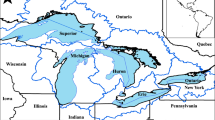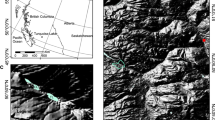Abstract
Eight new radiocarbon ages, all determined by accelerator mass spectrometry, on modern (pre-bomb) mollusks have been added to similar data provided from three samples in the Lake Michigan and Huron basins. These data confirm the existence of a substantial hard water effect correction ranging from about 250 years to 500 years in these lakes. They also show that the magnitude of these corrections form a spatially coherent pattern that can be related to the pattern of outcrop of Paleozoic (radioactively inert) carbonates that surround the basins and the pattern of circulation within the basins.
Similar content being viewed by others
References
Anonymous, 1988. The Great Lakes, An Environmental Atlas and Resource Book. U.S. Environmental Protection Agency and Environment Canada, Chicago, 44 pp.
Benson, L., 1993. Factors affecting 14C ages of lacustrine carbonates: Timing of the last highstand in the Lahontan Basin. Quat. Res. 39: 163–174.
Colman, S. M., L. D. Keigwin & R.M. Forester, 1994. Two episodes of meltwater influx from gkacial Lake Agassiz intoi Lake Michigan and their climatic contrasts. Geology, 22: 547–550.
Hough, J. L., 1958. Geology of the Great Lakes. Univ. of Illinois Press, Urbana, 313 pp.
Broeker, W. S. & A. F. Walton, 1959. The geochemistry of 14C in freshwater systems. Geochem. Cosmochem Acta 16: 15–38.
Lewis, C. F. M. & T. W. Anderson, 1989. Oscillations if levels and cool phases of the Laurentian Great Lakes caused by inflows from glacial Lakes Agassiz and Barlow-Objibway. J. Paleolim. 2: 99–146.
Mayle, F. E., A. J. Lavesque & L. C. Cwynar, 1993. Accelerator-masss-pectrometer ages for the Younger Dryas event in Atlantic Canada. Quat. Res. 39: 355–360.
Rea, D. K. & S. M. Colman, 1995. Radiocarbon ages of prebomb clams and the hardwater effect in Lakes Michigan and Huron. J. Paleolimnol. 14: 89–91.
Rea, D. K., T. C. Moore, Jr., C. F. M. Lewis, L. A. Mayer, D. L. Dettman, A. J. Smith & D. M. Dobson, 1994a. Stratigraphy and paleolimnologic record of lower Holocene sediments in northern Lake Huron and Georgian Bay, Canadian Journal of Earth Sciences, 31: 1586–1605.
Rea, D. K., T. C. Moore, Jr., T. W. Anderson, C. F. M. Lewis, D. M. Dobson, D. L. Dettman, A. J. Smith & L. A. Mayer, 1994b.Great Lakes paleohydrology: Complex interplay of glacial meltwater, lake levels, and sill depths, Geology, 22: 1059–1062.
Stuiver, M. & C. W. Pearson, 1993. High precision bidecadal calibration of the radiocarbon time scale, AD 1950 –500 BC, and 2500–6000 BC. Radiocarbon, 35: 1–23.
Stuiver, M. & P. D. Quay, 1981. Atmospheric 14C changes resulting from fossil fuel CO2 release and cosmic ray flux variability. Earth Plan. Sci. Letters, 53: 349–362.
Taylor, R. E., 1987. Radiocarbon dating: An Archeological Perspective. Academic Press. Orlando.
Author information
Authors and Affiliations
Rights and permissions
About this article
Cite this article
Moore, T., Rea, D.K. & Godsey, H. Regional variation in modern radiocarbon ages and the hard-water effects in Lakes Michigan and Huron. Journal of Paleolimnology 20, 347–351 (1998). https://doi.org/10.1023/A:1007920723163
Issue Date:
DOI: https://doi.org/10.1023/A:1007920723163




